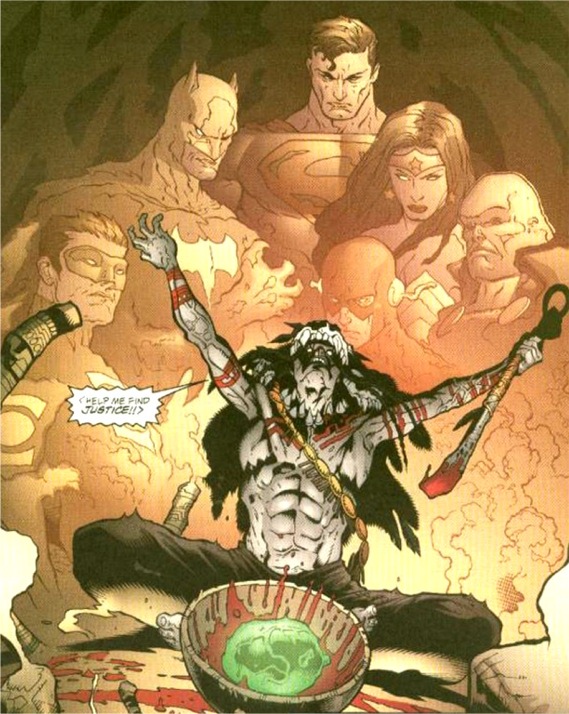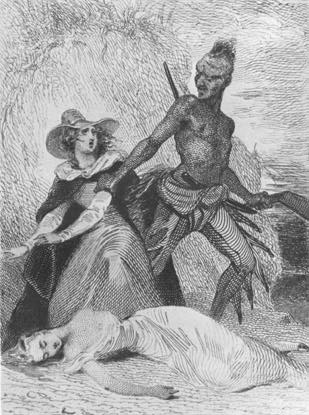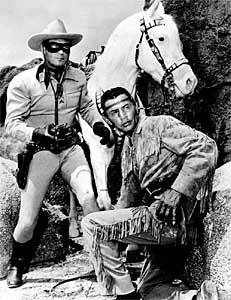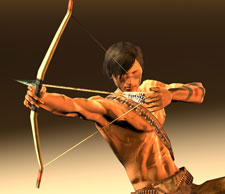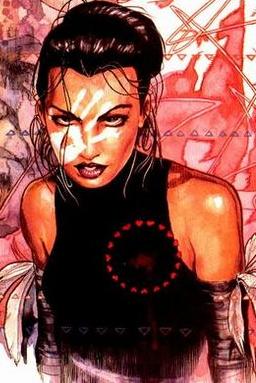
June 30, 2006
Lichtenstein inspired by Indians
A pop artist's fascination with the first AmericansCan there possibly be anything about the work of Roy Lichtenstein (1923-1997) that isn't already well known? Well, yes: his interest in the people of the Old West, particularly American Indians, which led him to incorporate their motifs in his work.
Lichtenstein's engagement with American Indian art is reflected in two periods of his career: his earliest work, and his Surrealist series of the late 1970s. The works on view range from a Cubist-oriented early canvas, "The Death of Jane McCrea" (1951), based on the 19th-century painting by John Vanderlyn about a young bride scalped by Indians, to "Amerind Figure" (1981), a wittily stylized life-size sculpture that's a kind of streamlined totem pole in black-patinated bronze. They include a stunning wool tapestry, "Amerind Landscape" (1979), a sophisticated composition with the design pizazz of Lichtenstein's style in full bloom. See Roy Lichtenstein: American Indian Encounters for more on the subject, including pictures.
Lichtenstein's engagement with American Indian art is reflected in two periods of his career: his earliest work, and his Surrealist series of the late 1970s. The works on view range from a Cubist-oriented early canvas, "The Death of Jane McCrea" (1951), based on the 19th-century painting by John Vanderlyn about a young bride scalped by Indians, to "Amerind Figure" (1981), a wittily stylized life-size sculpture that's a kind of streamlined totem pole in black-patinated bronze. They include a stunning wool tapestry, "Amerind Landscape" (1979), a sophisticated composition with the design pizazz of Lichtenstein's style in full bloom.
June 29, 2006
A balletic pioneer
Producers honor Maria TallchiefMaria Tallchief Paschen, Osage, was honored along with five other luminaries of the production world, a few known for their work on and off the set, at the Producers Guild of America's "Celebration of Diversity" awards in May.
According to the PGS's written bio on Tallchief, when she retired as a dancer in 1965, she passed on her love and valuable knowledge of ballet to young dancers. She became the artistic director and instructor of the Chicago Lyric Opera Ballet in 1975, and from 1981--'87 she served as the founder and artistic director of the Chicago City Ballet.
According to the PGS's written bio on Tallchief, when she retired as a dancer in 1965, she passed on her love and valuable knowledge of ballet to young dancers. She became the artistic director and instructor of the Chicago Lyric Opera Ballet in 1975, and from 1981--'87 she served as the founder and artistic director of the Chicago City Ballet.
Luiseño village reconstructed
A gallery of photos from a visit to the Pechanga reservation near Temecula, California:
New Year's Day, 2006
New Year's Day, 2006
Northwest Indian country
A gallery of photos from a road trip from Southern California to Washington and back:
Thanksgiving 2005--Seattle
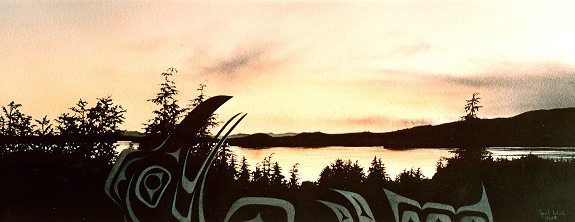
Thanksgiving 2005--Seattle

June 28, 2006
Stories: Not just entertainment
I'm reading Leslie Marmon Silko's Ceremony now. Here's a relevant quote from the beginning:
Ceremony
I will tell you something about stories,
[he said]
They aren't just for entertainment.
Don't be fooled
They are all we have, you see,
all we have to fight off illness and death.
You don't have anything
if you don't have the stories.
See Why Write Fiction: The Power of Storytelling for more on the subject.
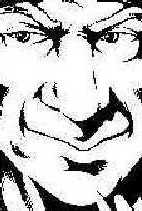
I will tell you something about stories,
[he said]
They aren't just for entertainment.
Don't be fooled
They are all we have, you see,
all we have to fight off illness and death.
You don't have anything
if you don't have the stories.
See Why Write Fiction: The Power of Storytelling for more on the subject.

The Indian-comic book connection
A quote from Maya "Echo" Lopez in DAREDEVIL #51:I remember that the tribes and the characters in the legends make me think of super heroes. The chief tells stories of power and responsibility.
When I was learning to read and speak, I learned a lot from comic books. Mythic scale quests that tell truth through metaphor. The word balloons in the comics made me think of smoke signals. Why do comics about Indians? In Why Write About Native Americans? I quoted James W. Loewen, who said:[O]ur ancestors are still there for us and can still speak to our conditions today. If we let them, if we in the present can portray a more complete and complex view of the past, then our children will have a better chance to build a future they will be proud rather than ashamed to remember. 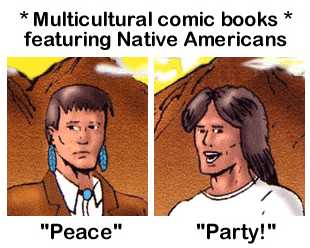
When I was learning to read and speak, I learned a lot from comic books. Mythic scale quests that tell truth through metaphor. The word balloons in the comics made me think of smoke signals.

From the sublime to the ridiculous
In DOC SAMSON #1, released in January, Marvel almost succeeded in reviving perhaps the lamest Indian character ever: the Living Totem. Previously, this “villain” was about what the name suggested: a walking, talking totem pole. Imagine a literal stick figure with stubby arms and legs threatening a Western hero.
In the new version, the comic explained that a jealous shaman had buried the spirit of a Haida warrior in a totem pole. When the pole was uncovered, it came to life as a stack of winged animals. The Living Totem still looked silly, but the revised origin made this goofball character at least a little believable.
In the new version, the comic explained that a jealous shaman had buried the spirit of a Haida warrior in a totem pole. When the pole was uncovered, it came to life as a stack of winged animals. The Living Totem still looked silly, but the revised origin made this goofball character at least a little believable.
More on the Southwest Museum
Gene Autry's Legacy and an Indian Museum Merge (and Collide)When one of the country's premier collections of American Indian artifacts joined forces three years ago with the collectibles of the Singing Cowboy, Gene Autry, the move was officially billed as a merger of equals.
This being Hollywood, however, the storyline was reduced to something simpler: the cowboys were once again battling the Indians.
Guess which side won. 
This being Hollywood, however, the storyline was reduced to something simpler: the cowboys were once again battling the Indians.
Guess which side won.

June 27, 2006
The mythology of the vanishing Indian
More from A Lingering Miseducation: Confronting the Legacy of Little Tree:From books like The Indian in the Cupboard, Little House on the Prairie, The Adventures of Tom Sawyer, and Two Little Savages (written by one of the early leaders of the American Boy Scouts, Ernest Thompson Seton) come stories of howling savages, sullen squaws and noble braves, pinto horses and buffalo-hide tepees, and legions of faceless, nameless Indians fading away before the inevitable forward-march of Euroamerican civilization.
Euroamerican children have suffered greatly from these images, for the mythology of the Vanishing Indian creates both a monocultural blindness and assumptions of supremacy (what Ward Churchill aptly titles {22} "Fantasies of the Master Race") as well as a visceral horror of digging too far into American history and discovering that a) the "inevitable vanishing" was neither inevitable or complete, as the battles for and against colonization are still being fought at the end of the twentieth century; b) the march of "civilization" has revealed itself to be simply an exercise of oppression and violence, and has turned technology into as much an ecocidal system as one of genocide; and c), this generation of colonialists, the children who accept the privileges of colonialism without question, is every bit as much responsible for the dispossession and slaughter of Indian peoples as their ancestors, even if they didn't do the shooting, raping, or removing themselves. This is a sad legacy for Euroamerican children to inherit, and with every new Indian-themed book published and film produced without regard to real Indians or real lives, they will continue to be educated into a centuries-old campaign of colonialist oppression. 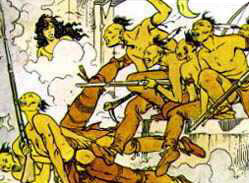
Euroamerican children have suffered greatly from these images, for the mythology of the Vanishing Indian creates both a monocultural blindness and assumptions of supremacy (what Ward Churchill aptly titles {22} "Fantasies of the Master Race") as well as a visceral horror of digging too far into American history and discovering that a) the "inevitable vanishing" was neither inevitable or complete, as the battles for and against colonization are still being fought at the end of the twentieth century; b) the march of "civilization" has revealed itself to be simply an exercise of oppression and violence, and has turned technology into as much an ecocidal system as one of genocide; and c), this generation of colonialists, the children who accept the privileges of colonialism without question, is every bit as much responsible for the dispossession and slaughter of Indian peoples as their ancestors, even if they didn't do the shooting, raping, or removing themselves. This is a sad legacy for Euroamerican children to inherit, and with every new Indian-themed book published and film produced without regard to real Indians or real lives, they will continue to be educated into a centuries-old campaign of colonialist oppression.

Taino urge Disney boycott
UCTP Stands in Solidarity with our Kalinago, Carib, and Garifuna RelativesOn behalf of the Taíno People and Nation represented by the United Confederation of Taíno People (UCTP), we are urging all our relations around the world to stand in solidarity with a peaceful protest against Walt Disney Pictures and their upcoming release of "The Pirates of the Caribbean: Dead Man's Chest" for its erroneous depiction of Caribbean Indigenous Peoples as savage cannibals.
From the time Christopher Columbus arrived on our shores, it is well known that these "cannibal" images were used as propaganda to enslave and murder Natives Peoples throughout the hemisphere, and beyond. 
From the time Christopher Columbus arrived on our shores, it is well known that these "cannibal" images were used as propaganda to enslave and murder Natives Peoples throughout the hemisphere, and beyond.

June 26, 2006
The problem with Little Tree
A Lingering Miseducation: Confronting the Legacy of Little TreeThe stereotypes and inaccuracies of Carter's depiction of Cherokee culture has been well-established. While Cherokee writer Robert J. Conley explains that in Cherokee culture "the sense of community is much stronger than the sense of the worth of the individual" (xii), Carter's Indians live apart from their tribal community as much in spirit and philosophy as in geographic proximity. Granpa, Granma, Little Tree, and Willow John are the only Indians around; reference to "the Nation" in Oklahoma is always with scorn or sadness. No mention is made of the Eastern Band of Cherokees in North Carolina. Carter's Indians claim to carry the memory and "Way" of their people, but only as a vanished or vanishing memory. The tribal community is dead in Little Tree, and none of the so-called Cherokees seem interested in reclaiming it.7 Instead of "[i]ndividual worth [being] defined in a community context" (xii), their worth exists wholly in their individuality. This fits well with Carter's belief in staunch individuality and libertarian self-reliance. His resistance to centralized power is as {30} apparent in his approach to the United States government as it is in the governments of the Cherokee Nation and the Eastern Band.
Granpa is the Noble Trickster, Granma the dignified Indian Princess (and a Cherokee Princess, no less!), and Little Tree is just what so many generations of Boy Scouts have dreamed themselves to be: the Little Brave roaming wild in the forest, with few rules and all sorts of generic "Indian" woodlore to consume and exploit. In most ways they are generic Indians, with few if any attributes that are distinctly Cherokee. None of them have any connection to the Cherokee clan system, which would have been quite unusual for Cherokees like Granma and Granpa during that time period, as historian John R. Finger points out....
Granpa is the Noble Trickster, Granma the dignified Indian Princess (and a Cherokee Princess, no less!), and Little Tree is just what so many generations of Boy Scouts have dreamed themselves to be: the Little Brave roaming wild in the forest, with few rules and all sorts of generic "Indian" woodlore to consume and exploit. In most ways they are generic Indians, with few if any attributes that are distinctly Cherokee. None of them have any connection to the Cherokee clan system, which would have been quite unusual for Cherokees like Granma and Granpa during that time period, as historian John R. Finger points out....
Battle for the soul of a museum
From the LA Times, 6/26/06:
Southwest Museum's future at heart of tussleThe coalition doesn't deny that the iconic Southwest building needs work and that the collection is getting better care now, she said. But in its zest to expand in Griffith Park, she said, the Autry is deliberately underestimating the 12-acre Mt. Washington site's potential as a museum location.
Not so, Gray maintains. Without the Autry's intervention in 2003, "the Southwest would have closed," he said. "And it would have closed for good reason. It didn't have the attendance, it didn't have the membership, it didn't have the public that was needed to keep the doors open." 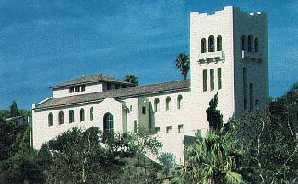
For more on the subject, see New Beginning for a Gem of a Museum.
Southwest Museum's future at heart of tussle
Not so, Gray maintains. Without the Autry's intervention in 2003, "the Southwest would have closed," he said. "And it would have closed for good reason. It didn't have the attendance, it didn't have the membership, it didn't have the public that was needed to keep the doors open."

For more on the subject, see New Beginning for a Gem of a Museum.
The Crazy Horse monument
Facts about the Crazy Horse mountain carving near Custer, S.D.When completed, the likeness of warrior Crazy Horse will sit astride his stallion, his left arm, almost as long as a football field, outstretched, pointing to his Sioux burial grounds.
The three-dimensional sculpture will be 563 feet high and 641 feet long--taller than the Washington Monument, the largest Pyramid at Giza or the Great Sphinx and almost twice the size of the Statue of Liberty. 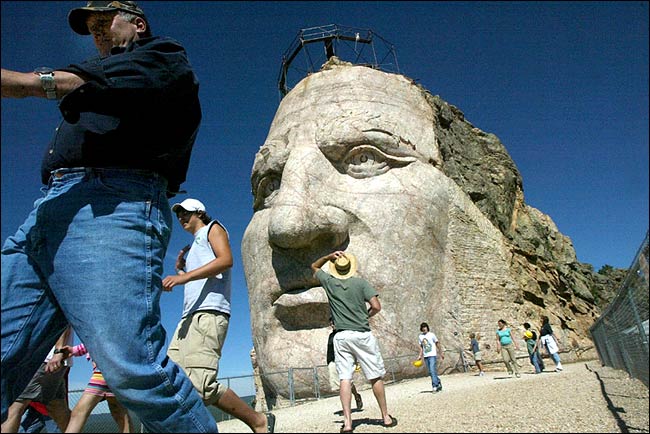
For a related topic, see Best Indian Monuments to Topple.
The three-dimensional sculpture will be 563 feet high and 641 feet long--taller than the Washington Monument, the largest Pyramid at Giza or the Great Sphinx and almost twice the size of the Statue of Liberty.

For a related topic, see Best Indian Monuments to Topple.
June 25, 2006
Preliminary Pirates protests
Pirates Picks Up Some Protestors[T]he blockbuster sequel already faced some protests last year while shooting on the island of Dominica. The Carib tribe that is indigenous to the island had a big problem with being portrayed as cannibals, particularly in a scene that has Johnny Depp strapped to a skewer. The tribe's chief Charles Williams was especially outraged that many of his people sold out their heritage for $95 per day as extras.
Now comes the real picketing-style protesting. The Garifuna American Heritage Foundation United of Long Beach, California is staging a protest at Disneyland on Saturday afternoon in response to their own problems with their ancestors being depicted as cannibals. The non-profit organization is devoted to the preservation of the Garifuna culture and history, so their interest in the matter is obvious. I wonder, though, if anywhere in the film is it said the cannibals are on Dominica. Not that it would really matter since there is no proof that cannibalism ever existed in the Caribbean, and the movie's encouragement of the stereotype probably suggests that all native Caribbeans as well as the African-originated Garifuna share a cannibalistic past. 
Now comes the real picketing-style protesting. The Garifuna American Heritage Foundation United of Long Beach, California is staging a protest at Disneyland on Saturday afternoon in response to their own problems with their ancestors being depicted as cannibals. The non-profit organization is devoted to the preservation of the Garifuna culture and history, so their interest in the matter is obvious. I wonder, though, if anywhere in the film is it said the cannibals are on Dominica. Not that it would really matter since there is no proof that cannibalism ever existed in the Caribbean, and the movie's encouragement of the stereotype probably suggests that all native Caribbeans as well as the African-originated Garifuna share a cannibalistic past.

Unpredictable Pilgrims and Indians
Looking at Pilgrims' story in new lightWho needs to read a book about the Pilgrims, whose hoary story every safety-scissor and construction paper-equipped American second-grader knows?
"Mayflower" author Nathaniel Philbrick would judge that a fair question. He writes that he began his project knowing both "the time-honored tradition of how the Pilgrims came to symbolize all that is good about America and the now equally familiar modern tale of how the evil Europeans annihilated the innocent native Americans.
"I soon learned that the real-life Indians and English of the seventeenth century were too smart, too generous, too greedy, too brave--in short, too human--to behave so predictably." 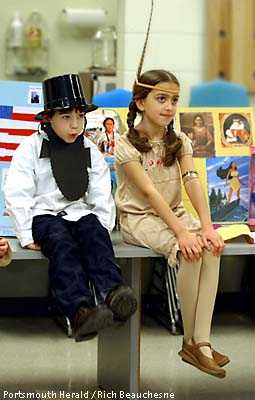
"Mayflower" author Nathaniel Philbrick would judge that a fair question. He writes that he began his project knowing both "the time-honored tradition of how the Pilgrims came to symbolize all that is good about America and the now equally familiar modern tale of how the evil Europeans annihilated the innocent native Americans.
"I soon learned that the real-life Indians and English of the seventeenth century were too smart, too generous, too greedy, too brave--in short, too human--to behave so predictably."

Kickin' it with Coyote
On the work of Native painter Harry Fonseca:
A cool, American Indian everymanHidden not so subtly beneath the lightheartedness of these works are examinations of native identity and the challenges many Indians face in trying to fit into mainstream urban life.
A telling example is "Coyote Chief with Cigars" (ca. 1993). Like virtually all Fonseca's works, it evokes a carefree feeling on the surface. But it confronts American Indian stereotypes, as embodied by the once-widespread, cigar-store Indian statues of decades past.
Although the depictions of Coyote have a loose, often cartoonish, pop look, these works should in no way be underestimated. Fonseca is a sophisticated painter with a knack for handling paint, as illustrated by the deft, Pollock-like splotches and swirls he uses to evoke the background surf in "Coyote on Skateboard No. III" (ca. 1995).
A cool, American Indian everyman
A telling example is "Coyote Chief with Cigars" (ca. 1993). Like virtually all Fonseca's works, it evokes a carefree feeling on the surface. But it confronts American Indian stereotypes, as embodied by the once-widespread, cigar-store Indian statues of decades past.
Although the depictions of Coyote have a loose, often cartoonish, pop look, these works should in no way be underestimated. Fonseca is a sophisticated painter with a knack for handling paint, as illustrated by the deft, Pollock-like splotches and swirls he uses to evoke the background surf in "Coyote on Skateboard No. III" (ca. 1995).
June 24, 2006
UND loves its mascot
Why does UND insist on being so hardheaded?Unfortunately, the "Fighting Sioux" name is popular with wealthy benefactors, some of whom would wear chicken feather headdresses and whoop it up at cocktail parties if they still could.
The university used to call its teams "Flickertails," but that name never attracted interest from Las Vegas casino owners who collected Nazi memorabilia and brought out cakes with Swastika icing to observe the birthday of Adolf Hitler. 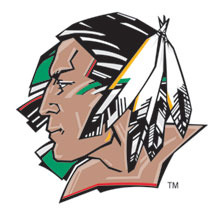
The university used to call its teams "Flickertails," but that name never attracted interest from Las Vegas casino owners who collected Nazi memorabilia and brought out cakes with Swastika icing to observe the birthday of Adolf Hitler.

Law & Order in the Old West
Dick Wolf, HBO Team Up on 'Wounded Knee'In their first collaboration, "Law & Order" mastermind Dick Wolf has teamed with HBO to develop a movie about the plight of American Indians during the 19th century.
The HBO Films project is based on the best-selling book "Bury My Heart at Wounded Knee: An Indian History of the American West," by Dee Brown. 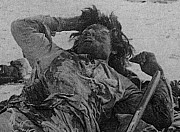
The HBO Films project is based on the best-selling book "Bury My Heart at Wounded Knee: An Indian History of the American West," by Dee Brown.

June 23, 2006
Bias in the bookstacks
The need for American Indian librariansAs with all little known topics in American society—in this instance American Indians and also libraries and their practices—background information is necessary. The Library of Congress (LC) classification systems or the Dewey Decimal Classification (DDC) system set the standards for all aspects of library organization throughout the U.S. and a large portion of the world. However, neither system adequately addresses the histories and contemporary realities of American Indians. For example, neither system has a category for "tribal sovereignty" and as a result even a book entitled "Tribal Sovereignty" might be classified under "Civil Rights—United States" or classed as a subtopic of "United States—History" but not as a concept of government. Under current classification practices this title could appear on library shelves next to titles such as the "Rosa Parks and the Montgomery Bus Boycott" or "Primitive Peoples of the U.S."—it would class "tribal sovereignty" along with other "historic events" NOT as an active governmental concept. Both LC and DDC have classifications for countries and state and local governments but none for tribal governments.
What is the message such practices convey to a student or researcher? Simply put: 1. that a subordinate status in U.S. history (the past) IS the "appropriate place" for American Indians (and everything about them), and 2. that "valid" or significant systems of government do not include tribal systems of government. Similar relegations to subordinate status occur throughout DDC and LC, examples: the paintings of Picasso, Monet, Warhol are classified as "Art"; while American Indian sandpaintings, pottery, basketry, etc. are classified as "crafts" or "primitive art"; Protestantism, Catholicism, etc. are classified under "Religion" while American Indian spiritual beliefs are classified as mythology, folklore, or "other religion", etc. And so it goes....In short, every American Indian perspective, accomplishment, or cultural belief, practice, or material product, according to these classification systems, is of a subordinate or inferior nature. 
What is the message such practices convey to a student or researcher? Simply put: 1. that a subordinate status in U.S. history (the past) IS the "appropriate place" for American Indians (and everything about them), and 2. that "valid" or significant systems of government do not include tribal systems of government. Similar relegations to subordinate status occur throughout DDC and LC, examples: the paintings of Picasso, Monet, Warhol are classified as "Art"; while American Indian sandpaintings, pottery, basketry, etc. are classified as "crafts" or "primitive art"; Protestantism, Catholicism, etc. are classified under "Religion" while American Indian spiritual beliefs are classified as mythology, folklore, or "other religion", etc. And so it goes....In short, every American Indian perspective, accomplishment, or cultural belief, practice, or material product, according to these classification systems, is of a subordinate or inferior nature.

Review of Trail of the Spanish Bit
The Trail of the Spanish BitAnyone who has held an antique in hand and felt the magnetic pull of the history of the object will enjoy this book. I had not previously been a student of Native American history or a fan of the Western book genre, but Coldsmith succeeds in creating characters to whom I could relate as fellow human beings. The device of linking past to present through the Spanish bit is ingenious. Comment: This book presents a great portrait of a generic Southern Plains tribe. All the Indians are three-dimensional individuals: realistic, down-to-earth, sometimes harsh or contrary.
Reflecting this, they don't have names like Soaring Eagle, Growling Bear, Pretty Flower, or Gentle Fawn. Instead, their names include Many Robes, Hump Ribs, Big Footed Woman, and Tall One.
About the only thing I object to is that the white man, Garcia, was instrumental in creating the Plains horse culture. I'm sure the Indians could have figured and did figure it out themselves.
Rob's rating: 8.0 of 10.
Reflecting this, they don't have names like Soaring Eagle, Growling Bear, Pretty Flower, or Gentle Fawn. Instead, their names include Many Robes, Hump Ribs, Big Footed Woman, and Tall One.
About the only thing I object to is that the white man, Garcia, was instrumental in creating the Plains horse culture. I'm sure the Indians could have figured and did figure it out themselves.
Rob's rating: 8.0 of 10.
June 22, 2006
Lies My Teacher Told Me
Author works to eradicate myths about Native cultureJames Loewen believes he's the only man who has intensively read 12 high school textbooks on history.
He calls it a “near death experience.”
That's because the books, he said, exclude scholarly research and borrow misinformation from older textbooks written during the nadir of racism--1890 to 1940--in the United States. Ultimately, students are taught myths, such as Indians sold Manhattan Island for $24. 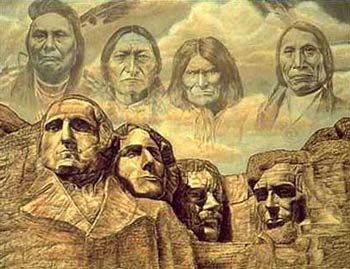
He calls it a “near death experience.”
That's because the books, he said, exclude scholarly research and borrow misinformation from older textbooks written during the nadir of racism--1890 to 1940--in the United States. Ultimately, students are taught myths, such as Indians sold Manhattan Island for $24.

Gumby does Hopi
Gumby and Pokey Early CartoonsRain Spirits
While Gumby and Pokey are swimming one day, a misplaced Hopi falls out of the sky, inquiring about rain spirits. They lead him back to his book, where they plant corn and Pokey is butted by a goat for not believing in rain spirits. They all go out and watch the Kachinas wander around the sky for a bit before Sky King Kachina meets Rain Cloud Kachina so that Corn Maiden Kachina can make the corn come up strong and sweet, which pleases the little Hopi, since now he doesn't have to starve.
The Kachinas
Taking place somewhere between the huge time gaps in Rain Spirits, this story begins with Gumby, Pokey, and the little Hopi walking straight up a sheer cliff to visit the Kachinas and beg them for rain. They concede, but on one condition: they must lay their first ear of corn on a high rock. We go through the corn growing footage again, only this time the Hopi takes an ear of corn and walks straight up a sheer cliff to set it on the high rock. Gumby and Pokey help harvest the corn, then they go and play in the Hopi's swimming pool. Pokey gets knocked in by the goat and Goat Spanking Kachina gives him a severe beating for his disobediance. 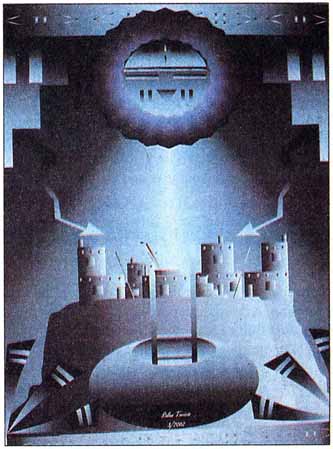
While Gumby and Pokey are swimming one day, a misplaced Hopi falls out of the sky, inquiring about rain spirits. They lead him back to his book, where they plant corn and Pokey is butted by a goat for not believing in rain spirits. They all go out and watch the Kachinas wander around the sky for a bit before Sky King Kachina meets Rain Cloud Kachina so that Corn Maiden Kachina can make the corn come up strong and sweet, which pleases the little Hopi, since now he doesn't have to starve.
The Kachinas
Taking place somewhere between the huge time gaps in Rain Spirits, this story begins with Gumby, Pokey, and the little Hopi walking straight up a sheer cliff to visit the Kachinas and beg them for rain. They concede, but on one condition: they must lay their first ear of corn on a high rock. We go through the corn growing footage again, only this time the Hopi takes an ear of corn and walks straight up a sheer cliff to set it on the high rock. Gumby and Pokey help harvest the corn, then they go and play in the Hopi's swimming pool. Pokey gets knocked in by the goat and Goat Spanking Kachina gives him a severe beating for his disobediance.

An old-time Indian cartoon
The Adventures of Pow Wow, the Indian BoyThe Adventures of Pow Wow first appeared from January 30, 1949 through March 13, 1949 as a very limited-animation local 15 minute Sunday morning program on New York's WNBT-TV. It reappeared in 1956 as a series of 39 five minute black and white films on CBS-TV's Captain Kangaroo show. Pow Wow was syndicated by Screen Gems to the eleven western U.S. states which did not air Captain Kangaroo at the time.
Based on Indian folklore, the fables included "How the Fox Got His White-Tipped Tale", "Pow Wow and the Stork", "How the Rabbit Got His Hop", "Pow Wow and Playing Possum", and "How the Turtle Got His Shell". The series left Captain Kangaroo's show in early 1958 and was syndicated beginning in May, 1958 as filler for local kid shows. 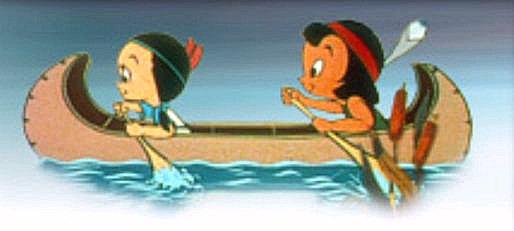
Based on Indian folklore, the fables included "How the Fox Got His White-Tipped Tale", "Pow Wow and the Stork", "How the Rabbit Got His Hop", "Pow Wow and Playing Possum", and "How the Turtle Got His Shell". The series left Captain Kangaroo's show in early 1958 and was syndicated beginning in May, 1958 as filler for local kid shows.

June 21, 2006
How others perceive us
Cowboys and Indians, Thai-styleFrom the grounds of Thailand's premier cowboy resort, a displaced Kansan explores the mysteries of the Far East's Wild West. 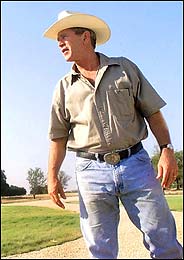
Comment: Note the Thai definition of "American freedom": "Riding horses and shooting guns." In other words, being a cowboy.

Comment: Note the Thai definition of "American freedom": "Riding horses and shooting guns." In other words, being a cowboy.
No genocide according to the dictionary?
Some people claim that technically speaking, what happened to the Indians wasn't genocide. They concede that the events were tragic, but argue that what happened doesn't quite meet the dictionary definition of "genocide." For one such claim and my response, go to Genocide by Any Other Name....
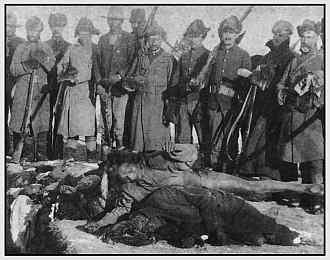

Black and brown should get greenlight power
More color, pleaseWouldn't Hollywood do a better job of creating movies that speak to this multiethnic audience if the studio executive suites weren't so lily white? It's an especially embarrassing question for the film industry, which is full of supporters of all sorts of progressive causes, but when it comes to hiring people of color, betrays a huge gap between its ideals and its actions.
"Forget about what's right, if you're dealing with a pop culture that's so driven by Latinos and African Americans, you'd think it would just be good practice to have people of color in those jobs," says Spike Lee, who's been a longtime advocate of improved Hollywood minority hiring practices. "But when they are making the big decisions, about greenlighting movies and TV shows, we're not participating.
"Forget about what's right, if you're dealing with a pop culture that's so driven by Latinos and African Americans, you'd think it would just be good practice to have people of color in those jobs," says Spike Lee, who's been a longtime advocate of improved Hollywood minority hiring practices. "But when they are making the big decisions, about greenlighting movies and TV shows, we're not participating.
First conviction in the blame-the-Indians scandal
Former White House Aide Convicted in Abramoff InquiryA former White House aide was convicted today of lying to government investigators about his ties to the disgraced lobbyist Jack Abramoff, in the first trial to result from the influence-peddling inquiry centered on Mr. Abramoff.
The verdict was hailed by Justice Department officials as a victory in their wide-ranging criminal investigation of the lobbying operations run by Mr. Abramoff, a Republican fundraiser who pleaded guilty in January to conspiring to go bribe public officials, including members of Congress, and is cooperating with prosecutors. 
The verdict was hailed by Justice Department officials as a victory in their wide-ranging criminal investigation of the lobbying operations run by Mr. Abramoff, a Republican fundraiser who pleaded guilty in January to conspiring to go bribe public officials, including members of Congress, and is cooperating with prosecutors.

June 20, 2006
Comics to the rescue!
Superhero flying to the rescue of native youthSuicide is a scourge among young aboriginals. But a new superhero, with eagle feathers in his hair and a red, white and blue suit that hugs his chiselled body, is flying in to the rescue.
His name is Wesakechak, named after the mythical shape-shifter and protector in Cree legends. But he's been updated for the 21st century with a flying motorcycle, superhuman strength and put inside a comic book now being distributed across the country for aboriginal youth. 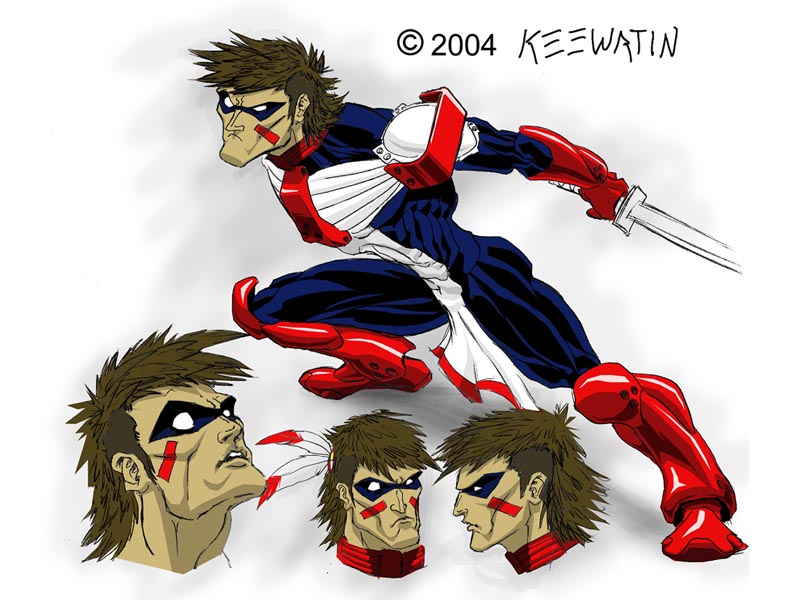
His name is Wesakechak, named after the mythical shape-shifter and protector in Cree legends. But he's been updated for the 21st century with a flying motorcycle, superhuman strength and put inside a comic book now being distributed across the country for aboriginal youth.

Star Trek's multicultural fallacy
'Neutralising the Indian': Native American Stereotypes in Star Trek: VoyagerStar Trek’s effort to produce an environment of equality and pluralism in space fails because it uses the assimilationist model for the Federation—described as 'a homo sapiens only club' by the Klingon Ambassador’s daughter in Star Trek VI: The Undiscovered Country [1991]. Any ‘alien’ that comes in contact with the organisation, or even the minority members of the cast, is made subordinate to a self-evident superiority. Newfield and Gordon (1996: 81) call this sort of assimilationism ‘assimilationist pluralism’ because it insists on conformity to the core even if it professes its belief in plurality. Henceforth Star Trek’s ‘IDIC’ ideology assumes then that everyone is equal in their diverse attributes but only if they are willing to accept the white dominated cultural control that the Federation symbolises. Star Trek’s multiculturalism is a fallacy and yet because it is assumed that Star Trek mediates a positive multicultural message, the thin layer of racial stereotyping and inequality is hidden. 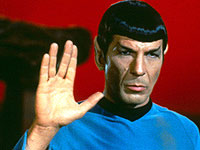

New film on La Llorona
Filmmaker brings legend to lifeThe legend—most popular in Hispanic cultures—of La Llorona, “the anguished spirit,” dates back to15th century Mexico and a woman named “La Malinche.” In 1522, Conquistador Hernan Cortes conquered the Aztec Empire with the invaluable aid of this Indian slave girl, who served as his diplomat, translator, strategist, lover and mother of his son, Martin.
She was vilified in her mother country, despite the fact she saved thousands of Indian lives by enabling Cortes to negotiate rather than slaughter.
La Malinche’s story becomes transformed somewhere in time into the anguished wailing of La Llorona, who in Mexican folklore drowned her children in a fit of insanity. Her spirit was condemned to wander for eternity and wail for her lost children along the rivers and lakes. 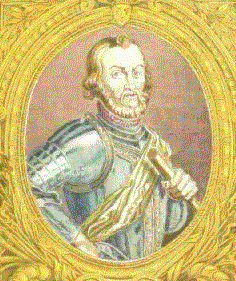
She was vilified in her mother country, despite the fact she saved thousands of Indian lives by enabling Cortes to negotiate rather than slaughter.
La Malinche’s story becomes transformed somewhere in time into the anguished wailing of La Llorona, who in Mexican folklore drowned her children in a fit of insanity. Her spirit was condemned to wander for eternity and wail for her lost children along the rivers and lakes.

Blankets with smallpox
The idea of Anglo-Americans giving smallpox-infected blankets to Indians has become a mainstream cultural reference. It signifies how bad the genocide was--how far the white men were willing to go to eliminate the Indians. That makes it a legitimate point of interest for students of pop culture like me.
So how bad were these early attempts at germ warfare? See The Facts About Blankets with Smallpox for the straight dope on the subject.
So how bad were these early attempts at germ warfare? See The Facts About Blankets with Smallpox for the straight dope on the subject.
Whiteys vs. Darkies vs. Redskins
Last November, Marc Fisher of the Washington Post wrote another of his pro-mascot columns. In particular, he claimed that "[a] parable about a football game between the Whiteys and the Darkies" was "based on a fallacy." See my recent posting for his commentary and my rebuttal.
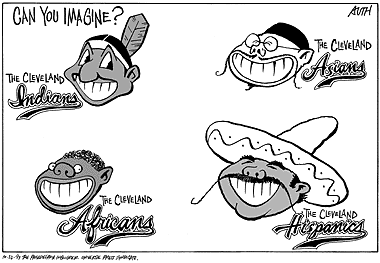

June 15, 2006
Indians take to the tube
Red Nation Web Television launches with a few glitchesA 24-hour Native cable TV network has been a decade-long dream of Joanelle Romero. And without the help of any television executives--just her friends and supporters--Romero launched the Red Nation Web Television Channel on May 1.
Born of Apache, Cheyenne and Jewish descent, Romero said she has received more than 200 entries for the network from Native filmmakers, actors and producers, and various entities to shape its around-the-clock programming of films, music videos, music specials, documentaries, pilots and drama series.
[T]he channel will feature the first Native drama series in the United States: "Home, Home on the Rez," starring Romero, Larry Sellers, Elaine Miles, Elizabeth Sage and Conroy Chino. Romero said the series is about a Native female attorney who leaves her big-time city job to return to her reservation to help children and teens in crisis. For more information, visit Red Nation.
Born of Apache, Cheyenne and Jewish descent, Romero said she has received more than 200 entries for the network from Native filmmakers, actors and producers, and various entities to shape its around-the-clock programming of films, music videos, music specials, documentaries, pilots and drama series.
[T]he channel will feature the first Native drama series in the United States: "Home, Home on the Rez," starring Romero, Larry Sellers, Elaine Miles, Elizabeth Sage and Conroy Chino. Romero said the series is about a Native female attorney who leaves her big-time city job to return to her reservation to help children and teens in crisis.

